JEBEDIAH
March 2011. By Greg Phillips. Pics Ken Leanfore
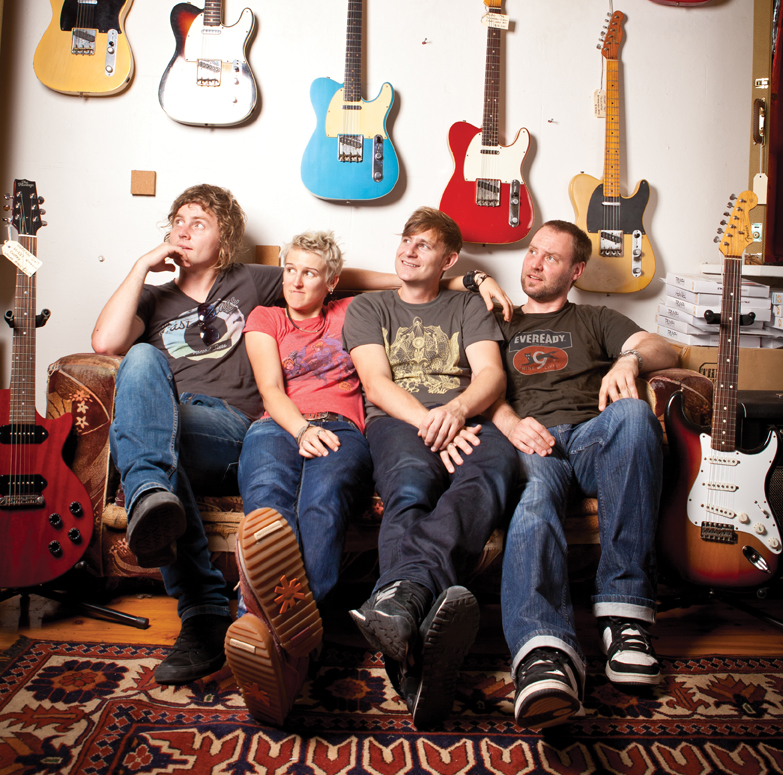 For fans of singer-songwriter Kevin Mitchell, the upside of the last half a dozen years has been the success of his alter-ego Bob Evans and more recently, the sweet sounds produced by Kev and his high profile mates in the Basement Birds. The downside of so much extracurricular output has been the inactivity of one of Australia’s most loved bands, Jebediah. The band’s last studio album ‘Braxton Hicks’ was released way back in July 2004. However, ardent jebediah fans already sense a whiff in the air, a change in the wind and a new album, ‘Kosciuszko’ due for release in April 2011. AM’s Greg Phillips caught up with the band in Sydney at the beginning of thier Summer Nerve Therapy tour to hang out at some cool music stores, catch their Annadale gig and discuss the next phase of the Jebediah story.
For fans of singer-songwriter Kevin Mitchell, the upside of the last half a dozen years has been the success of his alter-ego Bob Evans and more recently, the sweet sounds produced by Kev and his high profile mates in the Basement Birds. The downside of so much extracurricular output has been the inactivity of one of Australia’s most loved bands, Jebediah. The band’s last studio album ‘Braxton Hicks’ was released way back in July 2004. However, ardent jebediah fans already sense a whiff in the air, a change in the wind and a new album, ‘Kosciuszko’ due for release in April 2011. AM’s Greg Phillips caught up with the band in Sydney at the beginning of thier Summer Nerve Therapy tour to hang out at some cool music stores, catch their Annadale gig and discuss the next phase of the Jebediah story.
It’s an unseasonal tropical Sydney morning, perfect for a stroll along Parramatta Road to check out some guitars and basses with Jebediah’s Kev Mitchell and Ness Thornton. The band has recently finished tarcking the new album ‘Kosciuszko’ and only the mixing remains. During recording, Mitchell was particularly fond of the Epiphone Casino owned by engineer Dave Parkin and used it on most tracks. Kev’s almost convinced that this type of guitar will be his next purchase. We enter our first music store to see what treasures are on offer and we’re immediately confronted by a wall of beautiful vintage Telecasters. Kev gravitates to a ’61 Lake Placid Blue Tele.
Kev: The price tag is pretty impressive … twenty five grand!
A Candy Apple Red Tele next to it soon takes Kev’s attention.
Kev: The very first guitar I ever owned was a Japanese re-issue of this type of Tele, same colour, same everything. It’s the first time I have seen one that really looks like it. I mean, I don’t really keep up with how much guitars appreciate. I wouldn’t have a clue how much my Jag would be worth. I got it for about three grand in Perth. It’s really the first real guitar I’ve ever owned. Up until then I’d always used re-issues or cheap copies.
GP: Do you like the Tele sound?
Kev: I do like the Tele sound a lot, but I think playing the Jag, it’s more my sound. It’s just a little bit tougher. The Tele is still pretty tough. I don’t like Strats very much. For me a Strat represents more of the conservative side of rock n’ roll, I don’t know why? I think it’s because it is the most classic guitar used. I’m not by any stretch of the imagination a guitar nerd or aficionado of all things guitar. So that’s why I am so dismissive of that stuff and why I’ve played crap guitars for so many years.
GP: Tell me about your Jag.
Kev: It’s a 1969 model Fender Jaguar. I think I got it about 8 years ago. I got it at the time because I had been using Japanese Teles and the Jaguar had the sound of all of the 90s bands that I was into.
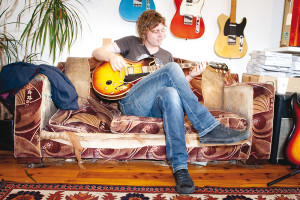 GP: Which sounds were you into?
GP: Which sounds were you into?
Kev: There’s the classic Nirvana sound. That Mustang or Jaguar, or cross between the two that Kurt had (Fender created two left handed proto-type Jag-Stangs for Cobain). I think that’s where it all stems from, my teenage love affair with Nirvana. I always keep going back to those sounds or feelings I suppose… the sound stays with you. Not to say you don’t change and learn along the way but there is something kind of special about it.
The ‘Jag’ was first released in 1962. It was based on the Jazzmaster, another Fender guitar first made in the late 50s. The majority of vintage Jaguars are sunburst, and other custom colours are more rare. Original Jag bodies were made of alder. The neck was made of maple with a rosewood fretboard and clay dot markers. After 1965, the clay dots were replaced with pearl. The pickups were much like any other Fender single coil pickups that were around at the time. Kev’s 69 model however features a humbucker at the back and single coil up front. Around 1967-68 Fender gave the Jaguar a larger headstock and stopped using nitrocellulose lacquer, and started finishing the neck and body in acrylic lacquer. The Jaguar was discontinued in 1975, but Fender began producing reissue models from 1986/87.
GP: So you’re working your way toward your signature model Jag?
Kev: (Laughs) Actually what I’d really like is a Kev Mitchell signature model Epiphone Casino! Or if they just put out a John Lennon re issue or something! On the new album, Kosciuszko, I used a Casino on just about every song, a nice old vintage one the producer (Dave Parkin) owns. I’d really love to pick one of those up. I also have a Rickenbacker, which I really like, but I think the Casino is where I am going to go.
GP: What were you running the Casino through while recording this album?
Kev: We were using those Badcat amp heads, which are really good. I had never even seen or heard of them before we made this record, and we also used a Fender Tonemaster. That’s what I use live now. There’s a Lab Systems head that we used too.
 GP: Ness, does being surrounded by a heap of beautiful guitars do anything for you? Do you ever pick up a guitar?
GP: Ness, does being surrounded by a heap of beautiful guitars do anything for you? Do you ever pick up a guitar?
Ness: I only started playing bass because these guys needed a bass player and they didn’t know anyone. It must have been about a year into the band, I thought I’m going to sell my Tele and my amp. I was living in a flat at the time. The elevator was broken so I lugged all my stuff down 4 flights of stairs. I just thought, If I don’t do this now, I am going to change my mind. You know, I’ll be forever in between bass and guitar type of thing.
Kev: So that would have been about ’96… quite a pivotal moment wasn’t it!
Ness: So I ran down the stairs with this big Fender amp and I went and traded it. I can’t even remember the last time I picked up a guitar.
GP: So you don’t miss it or get the urge to play?
Ness: No not at all. There is always someone else who is better or faster than me with any guitar laying around. Playing with Felicity Groom’s band (while Kev was doing his Bob Evans thing), there was always a guitar laying around and someone was always playing it.
GP: Kev, after the Bob Evans and Basement Birds experiences, do you feel the need to plug in and get dirty and distorted?
Kev: Definitely. I hadn’t really thought about electric guitars for the last five years and it’s only really been the last few months playing with Jebs that I’m making that mental shift and embracing the electric guitar again, and thinking of it more of as my first instrument. I guess that’s why I am thinking about getting a new guitar again because I am back in that zone of thinking about guitar tones. It’s been all about acoustic guitars and I do feel more competent on aqn acoustic. But being in a band with Chris, our lead guitarist … he’s more the electric guitar nerd too.
GP: I was thinking about the band’s sound and the thing that strikes me is that there is always something happening sonically. Someone is always doing something. Not a lot of gaps!
Kev: (laughs) That’s probably a bad thing!
Ness: Anytime there is some sort of gap in a song, inevitably someone will fill it in.
GP: So do you add the kitchen sink, then pull back or vice versa … add bits as you go?
Kev: With this record, we definitely added the kitchen sink, then pulled back. If we had left everything in we recorded … I mean we have been making this record for three years, so there’s a lot of stuff recorded. We still wanted to make a pretty expansive sounding record, but you do have to pull back at some point so you can let things come to the front.
Walking around the store Kev likes the look of a 1959 Sunburst Gibson ES-345. Price tag is a mere $28,500. Jackson’s David Roberts pulls it down for Kev to have a play with. Mitchell cautiously sits down with it to see how it feels in his hands. Chatting about the guitar’s sound, the discussion then turns to pedals.
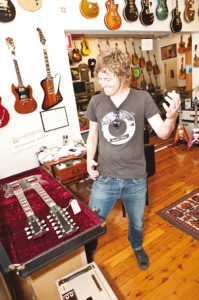 GP: What pedals did you use on the album?
GP: What pedals did you use on the album?
Kev: Just a Sans Amp distortion pedal. I have been using the same one for years. They are really versatile, just the array of tones you can get out of them, is great. I like to keep things really simple. I’m only playing rhythm guitar and singing. I like the Sans Amp, it’s by Tech 21 and an all-in-one distortion pedal.
GP: I imagine Chris’s pedal board takes up a lot of stage space anyway!
Kev: Yeah Chris has always had lots of pedals. He has just bought one of those things with lots of different effects.
Chris uses a Boss ME-70 multiple effects unit which features Compressor, Overdrive/distortion, Modulation, Delay, Noise Suppressor, Reverb, Pre Amp and Wah among many other goodies.
Ness: We always end up with his hand me downs. He used to use a Rat pedal. He gets bored easily and then Kev grabs them.
Kev: I often grab them before he gives them to me (laughs).
GP: Ness, you don’t use effects do you?
Ness: Hardly, just the odd thing here and there. There’s hardly any point. With two guitars, if I was to use effects, you wouldn’t know anyway half the time. Just more stuff to carry around unnecessarily. I just pulled my pedal board apart and gave my long leads to Kev. He’s the hand me down guy!
Having endured a guitar talk-fest at Jacksons, it’s only fair we take Ness a few doors down the road to the Bass People store.
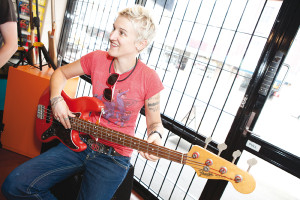 GP: Ness you’ve been a Fender player for a while now?
GP: Ness you’ve been a Fender player for a while now?
Ness: Both my basses are Fender Jazz’s and
I have had them forever. I have a ’71, my original which I bought with my own money from my 21st birthday money. I bought it at this tiny shop in the ‘burbs which I don’t think is there anymore. They had a bass section upstairs and
I remember going up and seeing that Blonde Jazz sitting there for $1,500, but it had active pickups. You know the type they use for slap bass. I put old pickups in it, it sounded heaps better.
GP: What do you run your basses through?
Ness: I run them through those Ashdown heads.
I bought one of those when they first came out, so I still have the same one. I think it’s 400 watts.
I have an old speaker box. It’s from the old Recovery studio and it never got used. It ended up back at Billy Hydes but they didn’t have a road case for it. There was a tour where we couldn’t fit a road case and I asked if I could take that. It has a 10″ and 15″ in a box. You never see them around. I hired it for that tour and at the end, I said I’m keeping it and just gave them some money. Then I found a JBL, 15″ speaker. They don’t make bass speakers anymore. Our tech found it and had a box custom made, so it’s a bit of a frankenstein rig but I have been using that for over a decade.
GP: You use a pick don’t you?
Ness: Yes, which is why I can’t use active pickups. I’d love not to use a plectrum. You get a nicer tone, but for me, there’s no feel. I can’t move
my arm.
GP: With your strings, do you use flatwound?
Ness: I do. I just switched to them. I used to use the D’Addario slow wounds. I used them for years, but they stopped making them. Every time I went to a new town, I’d just buy up all the stock they had. Then eventually they just ran out. I have tried a billion different strings after that and only recently found the flatwounds. I had them on a fretless I have. I was in the studio then and one of the guys who works there, had a P bass sitting there and it had flatwounds on it. I think I used it on one of the new album. So I had D’Addario flatwounds and thought, I’m going to try these. I used to change them about every 12 shows, which is a lot for me. I feel that’s the point where they are just wearing in and starting to lose that quacky tone and getting nice and round but my sound guy wants more clarity.

GP: Have you tried any basses apart from Fenders?
Ness: P Basses are the furtherest I would go from the Jazz Bass but even then, the neck is rounder or fatter. My ’69 has the thinnest neck. I have only got little hands. I’m a Fast-Fret person too. I remember Chris and Kevin somehow acquiring this little tin when we were younger …
Kev: We broke into a house on Rottnest Island when we were were about fourteen and stole a tin of Fast-Fret.
Ness: … and they gave it to me, and I have used it ever since. Now it’s probably a mental thing, but I can’t play without it!
Meanwhile, Ness checks out a new road worn 60’s style Jazz bass that Fender have begun producing. The Bass People’s Joel Burton pulls it down for her to have a look at. Ness comments that she’s never been a fan of faux vintage guitars, but is impressed with the detail of this one.
Joel Burton-Bass People: They do a pretty good job on these.
Ness: You can’t fake the neck though can you! It hasn’t got the worn look. It helps when you wear rings too, it wears down the corners. What about the pickups?
Joel: They wind them as close as they can to the originals. Fender have been doing this sort of thing on custom shop basses for a while. They call it relicking. On their custom shop basses, they go all out. So with your bass, they’d get it, and just copy it. With these ones, they’re made in Mexico… they get as close as they can but these are meant to be more affordable models.
Ness now spies a Jag bass
Ness: When were these things first made?
Joel: About five years ago. A lot of people ask when they started making these ‘again’, but it w as only recently they began. They’re made in Japan.
Ness: I saw one dude with a P Bass pickup as well as a Jazz style pick up in his bass
Joel: Yeah, Squire have just released one like that.
(It features Duncan Designed PB101 split single-coil Precision Bass middle-position pickup and a Duncan Designed JB102B Hot single-coil Jazz Bass bridge pickup.)
With guitar window shopping complete, it was time to head to the band’s hotel for a chat with all four members about the album then prepare for the Annandale Hotel gig that night
WHAT ABOUT THIS NEW ALBUM THEN?
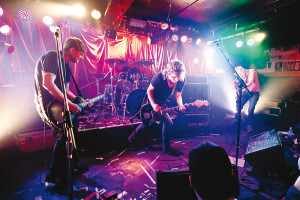 Back at the band’s hotel, kev and Ness are joined by drummer Brett Mitchell and guitarist Chris Daymond
Back at the band’s hotel, kev and Ness are joined by drummer Brett Mitchell and guitarist Chris Daymond
Due for release in April is ‘Kosciuszko’, Jebediah’s brand spankin’ new album. The title came about after Mitchell had been reading that The Beatles had intended to name one of their albums Everest (It eventually became Abbey Road). Kosciuszko was simply a more personalised variation on that theme. With the new album came a new enthusiasm and philosophy. Whereas once Jebediah would conform to tried and true studio frameworks, this time they threw caution to the wind. “If anyone had something different they wanted to do, then they had free reign. So much of this record was created on the spot. We used the studio like a fifth member of the band.” Mitchell said of the Kosciuszko recording creed.
On first listen, there would seem to be more attention paid to the vocals than on any previous Jebediah albums. I put two and two together and assumed this was due to the influence of Mitchell’s recent stint with the harmonious Basement Birds, however I was wrong. It had more to do with perceived criticism of his vocal delivery on other Jeb’s records, explained Mitchell. “I think every time I have made a Jebediah record, I have tried to get the vocals better and better. Probably stemming from the very early days where … if there was ever a criticism about the band, it was about my singing. That has always stayed with me a bit. I have always tried to get it to a point where that criticism can’t be levelled anymore.”
While taking a different recording approach and also producing a more polished Jebediah sound than usual, it’s no less catchy and they’ve still retained plenty of power. But the devil may care studio attitude has left the band with a new conundrum … interpreting the songs live. “We are going to have to relearn, reinterpret the songs and it will be a challenge we haven’t had to face before,” said Kev Mitchell. Brett Mitchell elaborated.”It’s the first time we have talked about maybe firing off a couple of samples. We wouldn’t be comfortable with sequencers or backing tracks as such, but rather having some triggers on hand for a few key parts.”
KOSCIUSZKO TRACK BY TRACK
Lost My Nerve
GP: There’s a lot going on in the background of this one.
Chris: I’m not doing anything special there. That just all of Kevin’s crazy brain explosion
Kev: Me and Parko throwing as much crap in there over a four hour period as we could.
Chris: That was a song written pretty much on the spot
Oxygen
Kev: Brett brought this little keyboard in that had a vocoder on it. We pretty much put the chords together in a jam. But when we took it into the studio it was too straight so we literally took out everything. All we left was the drums and started all over again.
Chris: Also there are a couple of other songs which are similar kinds of pop songs, same structure. So when it came to ideas, the weirder the better for that one, to try to pull it in another direction.
GP: What’s the white noise in the background, is that you?
Chris: Yeah there’s a guitar synth pedal that I have which is part of the Line 6 range. We were just trying to find the craziest sounds we could and build up layers of unusual melodies underneath the vocals. And writing to the sound, finding the sound first
She’s Like A Comet
GP: This song has that Midnight Oil solid chord surf strum sound that some of the album reminds me of.
Kev: It was written quickly and is one of the oldest songs written. The thing I like about that song is that the chords don’t change from verse to chorus, which does show it was written quickly.
To Your Door
GP: This one is pumped along by Ness’s loping bass beat. Did you use the same bass on each track because there seems to be some tonal differences on some tracks.
Ness: The only time I used different basses would be the verses of *’Reds’ (Under Your Bed), I used the P Bass. The rest was just the Jazz and Parko’s magic.
* Under Your Bed (nicknamed ‘Reds’ )
Control
GP: The intro has a nice acoustic tone
Kev: We used a Mini Maton. They are really interesting sounding, acoustically. We did use an electric and had a few goes before we arrived at the final sound.
GP: Another track where the guitar sounds, although chaotic, are warmer than previous albums.
Kev: It probably helped too having a producer who is a guitar player.
Chris: Dave is great to work with as far as guitars go.
Ness: To me this is the album where the bottom end is represented more like us, whereas if you listen to the third album, it’s all guitar. All I can hear is that really toppy guitar sound with nothing else in there. Even though Parko is a guitarist, I reckon he has really represented me well and you can hear the bass as much as the guitars. It’s a really even spread of the four of us.
Chris: Yeah, he served the band.
Battlesong
GP: A nice breathing spot in the album with its intro, then it turns into this raucous pirate song! Did you get to the chorus and think, let’s make this more of a singalong thing. It’s the kind of tune you can imagine drunken mates singing with their arms around each other.
Kev: Well the chorus came first and we had to write everything else around it. The rhythm and feel of it made us think about The Pogues, who are a beer swilling pub band.
GP: And what are you doing in the background of that one Chris?
Chris: We are both going hammer and tongs on that one. I came up with a bit for the bridge that we drop into. We just played around with things to change the face of the song before it builds back up again because it’s a pretty full-on chorus.
GP: What were you using?
Chris: A lot of this album was my Les Paul Showcase, which is an active pick up Les Paul. Most of it was through a Tonemaster. I have a Fender Princeton and we set that up in the control room. That was really good with a Casino as well. We used a lot of gain, so there’s not a lot of clean tones. For clean tones, I’d use my Strat. I used various effects. I don’t really have favourites.
Freakin Out
GP: Another song pumped along by Ness and Brett. There’s quite a bit of that feel to the album, the power behind and the sweetness on top.
Kev: Yeah thanks. Freakin Out was another one that took ages to get right. We tried so many different ways. It was a real puzzle that one.
Brett: I think because there was that pseudo disco vibe in the chorus and I wasn’t quite sure what to do with it. In the end it became a couple of tracks for the drums, maybe lay the hi hats down separately to get that distinct groove through it.
The Lash
GP: There seems to be some incidental percussion happening in the background?
Brett: I think my favourite was the paper rip, which even if I do say so myself, I turned out to be quite good at! Many years ago I picked up a bunch of percussion stuff. I used to work in a drum shop in Perth. We got a shipment from China of shakers and some metallic shakers, triangles, guero type things. I think we pretty much put as much as we could in there, then Parko moved bits and pieces around. I guess it was created fairly synthetically in the end, but yeah, every percussion thing we had, we tried.
High (Horse)
GP: Seems to be the kind of song you couldn’t begin a gig with. You’d need a few songs under your belt first before you attacked that one live?
Ness: That’s exactly what Kevin has said … wouldn’t it be great to start the set with that song. It would be awesome, but we just couldn’t do it … well I could not anyway. I cannot get into that groove cold.
Kev: How about playing it second? (laughs)
GP: Sorry I mentioned it Kev.
Ness; It’s funny that you said that because we have definitely discussed it. It has come up! it would be awesome to start the set with that song but I just can’t get that groove so quick. I need to warm up to get to that stage.
Are We OK?
GP: Has almost an air raid siren-like sound at the beginning.
Kev: That was Parko, probably on guitar. I’ve never thought of it like that. That was just him on slide guitar through some effect, probably a tape echo.
Ness: That was a song we were jamming on at the end of one session and laid down a guide track, then when we got to the next session, Parko had created that loop. Everyone had a different idea about that song and Parko wanted to keep everyone happy. So he said he’d incorporate a bit of everyone’s ideas
For more info: www.jebediah.net
Thanks to Ken Leanfore for the great pix, and Kathleen Hore from Secret Service for the hospitality.


